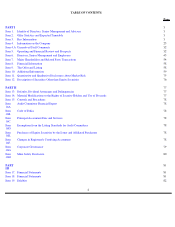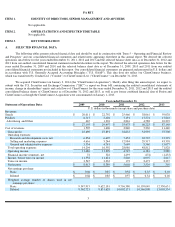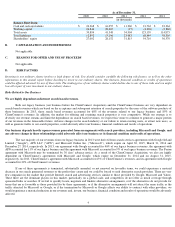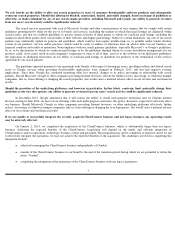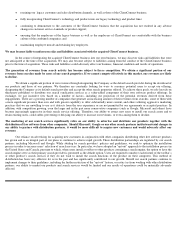Incredimail 2013 Annual Report Download - page 16
Download and view the complete annual report
Please find page 16 of the 2013 Incredimail annual report below. You can navigate through the pages in the report by either clicking on the pages listed below, or by using the keyword search tool below to find specific information within the annual report.
Our results of operations and financial condition may be adversely impacted by worldwide economic conditions.
Our primary user base is composed of individual consumers and for the most part their discretionary purchase habits. In the event that
the United States or Europe experiences an economic downturn, or the current economic climate worsens, our current and potential software
license subscribers may be unable or unwilling to purchase our products or use our service. This would also have a negative impact on consumer
Internet spending and search generated revenues. A reduction in the purchasing of our products or use of our services, consumer internet
spending and search generated revenues have had a negative impact in the past, and may possibly have a greater negative impact in the future, on
our sales and revenue generation, margins and operating expenses, and consequently have a material adverse effect on our business, results of
operations and financial condition.
Exchange rate fluctuations may harm our earnings if we are not able to hedge our currency exchange risks effectively.
A majority of our revenues are denominated in U.S. dollars. However, a significant portion of our sales is in currencies other than the
U.S. dollar, either received directly by us in these currencies or received by our search partner in other currencies, but first converted into U.S.
dollars prior to being transferred to us. In 2013, approximately 9% of our revenue was received directly by us in non-
U.S. currencies and an
estimated 49% of our revenue was received by our search partners in non-
U.S. currencies, although converted by our search partners into U.S.
dollars prior to being transferred to us. As a majority of the sums received in non-
U.S. currencies, their precise currency, timing or amounts
received by our partner is not known by us, we are unable to hedge against the risk of fluctuations in these exchange rates and we bear a foreign
currency fluctuation risk. In addition, a substantial part of our costs, mainly personnel expenses, are incurred in NIS. Inflation in Israel may have
the effect of increasing the U.S. dollar cost of our operations in Israel. Further, whenever the U.S. dollar declines in value in relation to the NIS,
it will become more expensive for us to fund our operations in Israel. A revaluation of one percent of the NIS as compared to the U.S. dollar
could reduce our income before taxes by approximately $0.03 million. The exchange rate of the U.S. dollar to the NIS has been very volatile in
the past three fiscal years, decreasing by approximately 4% in 2011, increasing by approximately 8% in 2012, and decreasing by approximately
6% in 2013. As of December 31, 2013, we had a foreign currency net liability of approximately $0.1 million and our total foreign exchange
income was approximately $69,000 for the year ended December 31, 2013. In addition, in market territories where our prices are based on local
currencies, fluctuations in the dollar exchange rate could affect our gross profit margin. To assist us in assessing whether or not, and how to,
hedge risks associated with fluctuations in currency exchange rates, we have contracted a consulting firm proficient in this area, and are
generally implementing their proposals. Based on the advice received from this firm, we are advised that we are unable to hedge exchange risks
associated with revenues indirectly originating in non-
U.S. dollar currencies, but received in U.S. dollars. We do not hedge the exchange risk
from revenues received directly by us in non-
U.S. currencies, as the amounts of these revenues are not material. However, due to market
conditions, volatility and other factors, we do not always implement our consultant’s proposals in full and our consultant’
s proposals do not
always prove to be effective and may even prove harmful. We may incur losses from unfavorable fluctuations in foreign currency exchange
rates. See "Item 11 Quantitative and Qualitative Disclosure of Market Risks" for further discussion of the effects of exchange rate fluctuations on
earnings.
A loss of the services of our senior management and other key personnel could adversely affect execution of our business strategy.
We depend on the continued services of our senior management, particularly Josef Mandelbaum, our Chief Executive Officer. Our
current strategy is to a great extent a function of his capabilities and experience, together with the experience and knowledge of our other senior
management. The loss of the services of these personnel could create a gap in management and could result in the loss of expertise necessary for
us to execute our business strategy and thereby adversely affect our business. We do not currently have "key person" life insurance with respect
to any of our senior management.
Further, our ability to execute our business strategy also depends on our ability to continue to attract, retain and motivate qualified and
skilled technical and creative personnel and skilled management, marketing and sales personnel. Competition for well-
qualified employees in
our industry is intense and our continued ability to compete effectively depends, in part, upon our ability to retain existing key employees and to
attract new skilled employees as well. If we cannot attract and retain additional key employees or lose one or more of our current key employees,
our ability to develop or market our products and attract or acquire new users could be adversely affected. Although we have established
programs to attract new employees and provide incentives to retain existing employees, particularly senior management, we cannot be assured
that we will be able to retain the services of senior management or other key employees as we continue to integrate the ClientConnect business
into our business, or that we will be able to attract new employees in the future who are capable of making significant contributions. See "Item 6
Directors, Senior Management and Employees."
12


